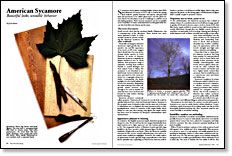
Synopsis: Sycamore can be as unstable as it is beautiful, writes Jon Arno. This article helps one better understand and use it, discussing its history, name, appearance, and properties. He talks about its instability and about how it cures evenly, and offers tips on slicing it thin and using it. He offers charts comparing stability of sycamore vs. common cabinet woods, and a side article by Alex Waters of Fine Woodworking discusses uses and finishes.
Sycamores can be giants, reaching heights of more than 100 ft. and diameters in excess of 10 ft. Late to leaf in the spring, their majestic, gnarly branches and patchy, ash-gray bark have led sycamores to be called “ghost trees”. But for woodworkers, it can be a challenge to craft the wood into lasting projects, That’s because sycamore can be as unstable as it is beautiful. To better understand and use this giant of the forest, let’s look first at its history and its name.
The roots of sycamore
Fossil records show that the sycamore family, Platanaceae, was a contemporary of the dinosaurs. These ancient tree specimens spawned at least 11 of the modern sycamore species, including the American sycamore, Platanus occidentalis.
Practically unchanged, American sycamore’s rapid growth rate, impressive size and life expectancy of as much as 600 years suggest that it should have become an important timber species in North America. In terms of biomass, American sycamore is arguably the largest hardwood tree in North America. And sycamore’s range is extensive, running from northern Florida to central Michigan and from eastern Texas to Maine. But sycamore is not abundant in upland forests. Its lack of shade tolerance and need for rich, moist soil cause it to congregate along river banks. Consequently, the ample sunlight of a river bank habitat lets it form low branches, diminishing the value of its logs. Few of the oldgrowth stands survived long enough to be used as lumber because the trees were cut down and burned by early settlers clearing land for farming.
American pioneers commonly called sycamore “buttonwood” because its woody fruit could be quickly fashioned into crude but functional buttons. Sycamore is the accepted name in America today, but the same tree in Europe is called plane tree. In England, the name sycamore refers to Acer pseudoplatanus, which is a member of the maple family. Much whiter in color and often having curly figure, the maple variety has been used for furniture by European cabinetmakers since classical times.
Appearance: pleasant to stunning
In contrast to the English sycamore/maple, American sycamore is deeper in color. Wood cut from the tree ranges dramatically from dark heartwood to light sapwood. The tangential surface of flatsawn boards (growth rings parallel to the face) reveals a subtly pleasant figure freckled by a multitude of light-yellow ray flecks. Often, the flecks are partially obscured by the wood’s overall yellowish-gray color and occasional warm reddish-tan highlights.
From Fine Woodworking #110
For the full article, download the PDF below:
Fine Woodworking Recommended Products

DeWalt 735X Planer

Ridgid R4331 Planer

AnchorSeal Log and Lumber End-Grain Sealer






















Log in or create an account to post a comment.
Sign up Log in